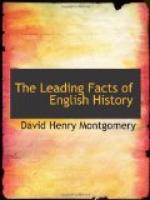445. Marston Moor and Naseby, 1644, 1645.
On the field of Marston Moor, Yorkshire, 1644, the north of England was conquered by Cromwell with his invincible little army. The following year Cromwell’s “Ironsides,” who “trusted in God and kept their powder dry,” gained the decisive victory of Naseby, 1645, in the Midlands. (See map facing p. 252.) After the fight papers belonging to the King were picked up on the battlefield. They proved that Charles intended betraying those who were negotiating with him for peace, and that he was planning to bring foreign troops to England. The discovery of these papers, which were published by Parliament, was more damaging to the royal cause than the defeat itself.
446. The King and Parliament.
Standing on the walls of the ancient city of Chester, Charles saw his last army utterly routed (1645). Shortly afterwards he fled to the Scots. Oxford, the King’s chief city in the Midlands, surrendered to Fairfax (1646). The first civil war was now practically over. The Scots gave up the King (1647) to the parliamentary commissioners, and he was taken to Holmby House, Northamptonshire. There Cromwell and the army made overtures to him, but without effect. He was then brought by the Parliamentary or People’s army to Hampton Court, near London.
Here, and elsewhere, the army again attempted to come to some definite understanding with the King, but all to no purpose. Politically speaking, Charles was his own worst enemy. He was false to the core, and, as Carlyle has said: “A man whose word will not inform you at all what he means, or will do, is not a man you can bargain with. You must get out of that man’s way, or put him out of yours.”
447. The Second Civil War (1648); Pride’s Purge (1648); the “Rump Parliament.”
After two years spent in fruitless negotiations, Charles, who had fled to Carisbrooke Castle in the Isle of Wight, made a secret treaty with the Scots (1648), promising to sanction the establishment of the Scotch Presbyterian Church in England (S444), if they would send an army into the country to restore him to the throne.[1]
[1] When Cromwell found out that Charles had resolved to destroy him and the Independent army, he apparently made up his mind to put the King to death. See Lord Broghill’s story in S. R. Gardiner’s “History of the Great Civil War,” III, 259.
The Scots marched into England, the Royalists rose to aid them, and the second civil war began. It speedily ended in the utter defeat of the King’s forces. The People’s army now vowed that they would bring the King to justice. To this neither the Presbyterians in the House of Commons nor the members of the House of Lords would agree.
Colonel Pride then proceeded (1648), as he said, to purge the “Long Parliament” (S439) by driving out all who were opposed to this measure. Cromwell had no part in Pride’s expulsion of members, though he afterwards expressed his approval of it. Those who remained were a small body of Independents only (SS422, 439). They did not number sixty; they became the mere tool of the Parliamentary or People’s army and were called in derision the “Rump Parliament.”




